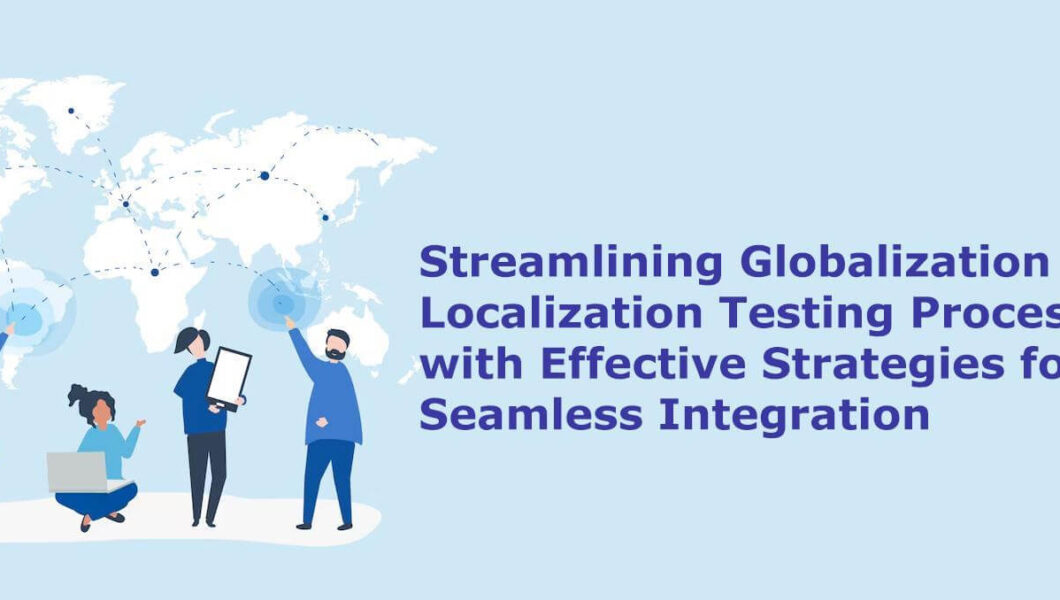In a modern interconnected world, businesses are expanding their reach beyond borders, catering to diverse markets worldwide. However, achieving success in global markets requires more than just translating content. It demands meticulous testing processes to ensure that products and services resonate with local cultures, languages, and preferences. This is where globalization and localization testing play a pivotal role. To streamline these processes and ensure efficiency and accuracy, companies must employ effective strategies.
This blog, we’ll delve into key strategies for optimizing globalization and localization testing processes.
Early Integration of Localization:
Begin thinking about localization during the early stages of product development. Integrate localization requirements into the design and development phases to minimize rework and ensure seamless integration of localized content. By involving localization teams from the outset, companies can address potential issues upfront, saving time and resources in the long run.
Standardization of Processes:
Establish standardized processes and workflows for localization testing and globalization testing across projects. Document these processes comprehensively to ensure consistency and clarity. By following standardized procedures, teams can streamline testing activities, reduce errors, and enhance overall efficiency.
Automation of Testing Procedures:
Leverage automation tools and technologies to streamline testing procedures. Automated testing frameworks can help accelerate the testing process, improve test coverage, and identify localization bugs more efficiently. Implementing automation also frees up valuable human resources, allowing teams to focus on more complex testing tasks.
Comprehensive Test Coverage:
Develop comprehensive test plans that cover all aspects of globalization and localization, including linguistic validation, functional testing, UI/UX testing, and cultural appropriateness assessment. Ensure that tests are conducted across various platforms, devices, and locales to identify potential issues and inconsistencies.
Use of Localization Management Platforms:
Invest in localization management platforms that facilitate collaboration, streamline workflows, and centralize project management activities. These platforms offer features such as translation memory, glossary management, version control, and real-time collaboration, enabling teams to work more efficiently and effectively.
Continuous Monitoring and Feedback:
Implement a robust feedback mechanism to gather insights from in-country reviewers, linguists, and end-users throughout the testing process. Continuous monitoring allows teams to address localization issues promptly, iterate on translations, and ensure alignment with local market expectations.
Cultural Sensitivity Training:
Provide cultural sensitivity training to localization teams and testers to enhance their understanding of local cultures, customs, and sensitivities. This awareness helps in ensuring that localized content is culturally appropriate and resonates with target audiences, thereby minimizing the risk of cultural faux pas.
Iterative Testing Approach:
Adopt an iterative testing approach that involves multiple rounds of testing and refinement. Begin with basic linguistic validation and functional testing, gradually moving towards more complex scenarios and edge cases. Iterative testing allows for continuous improvement and ensures that localized products meet quality standards.
Cross-Functional Collaboration:
Foster collaboration between cross-functional teams, including developers, testers, translators, content creators, and subject matter experts. Encourage open communication and knowledge sharing to address localization challenges effectively and capitalize on each team member’s expertise.
Performance Benchmarking and Analysis:
Establish performance benchmarks and conduct regular analysis to measure the effectiveness of globalization testing and localization testing processes. Monitor key metrics such as time-to-market, defect density, customer satisfaction, and ROI to identify areas for improvement and optimize testing strategies accordingly.
In conclusion, streamlining globalization and localization testing processes is essential for ensuring the success of products and services in diverse international markets. By implementing the aforementioned strategies, companies can enhance efficiency, accuracy, and overall quality, thereby gaining a competitive edge and driving business growth on a global scale. Embracing innovation, automation, collaboration, and continuous improvement are key to achieving seamless integration and localization excellence in today’s dynamic global landscape.




